- About us
- Support the Gallery
- Venue hire
- Publications
- Research library
- Organisation chart
- Employment
- Contact us
- Make a booking
- Onsite programs
- Online programs
- School visit information
- Learning resources
- Little Darlings
- Professional learning
3 minutes 48 seconds
“Prime Minister Gough Whitlam pours soil into the hand of traditional landowner Vincent Lingiari 1975” by Mervyn Bishop
A colour photograph 60 cm high x 50 cm wide. Against the backdrop of a blazing blue sky, Gough Whitlam, then Prime Minister, and Vincent Lingiari, Girindji elder, stand in the foreground, their figures dominating the busy outdoor scene. Whitlam pours red soil into Lingiari’s open cupped hand.
Filling the top half of the picture is a clear brilliant blue sky. Midway down on the left edge there are a couple of spikey tree branches, on the right edge an open shed with a grass thatched roof and dark shade beneath. In the mid ground several men, wearing long flared pants and Stetson hats are moving away from the shed. The earth is vibrant rusty red, dry and compacted.
Gough Whitlam, in his late 50s, stands on the right side of the picture; he is positioned front on, his head turned toward the left. His receding grey hair is combed back off his forehead and behind his ears, his fair skin glistens in the bright sunlight. He has thick dark arched eyebrows, his eyes looking diagonally downward. He has a long sharp nose, flushed full cheeks and parted lips. His right arm is raised forward of his body just below shoulder height, the elbow is bent and his fist clenched, red soil trickles through its grip. His left arm, down by his side, cocks out slightly from his body, as if balancing. He is leaning forward and to his right. The picture is cropped below his knees. He is wearing a mid-grey buttoned suit jacket with matching trousers, a pale blue collared shirt and a tie with diagonal navy, pale blue and white stripes.
Vincent Lingiari, in his mid-50s, stands on the left of the picture, he is positioned closer to the foreground, in profile facing the right. He is shorter than Whitlam. His thin short silver hair gleams in the sunlight, longer wisps sweeping upward, silhouetted by the blue sky. His has dark brown skin, a high forehead and broad curved nose. He is looking diagonally downward, his deep brown lips closed. He leans forward, his right elbow raised, his hand cupped open with a small mound of red soil resting within it. In his left hand he is holding pieces of foolscap paper, a document, horizontally at waist height. He is wearing a crisp light blue chambray shirt buttoned to the neck and high waisted dark blue chambray pants that are hand stitched from waist to hip with white thread in a vertical line. The picture is cropped at the middle of his thighs.
Audio description written by Marina Neilson and voiced by Krysia Kitch
Mervyn Bishop started his career in photojournalism in 1963, when he started a cadetship with the Sydney Morning Herald. In 1974 he became staff photographer for the Department of Aboriginal Affairs, in which role he took this iconic photograph of the ceremony by which 3250 square kilometres of Gurindji country was returned to traditional owners in August 1975. The image shows Gurindji Elder Vincent Lingiari (1919–1988) and then Prime Minister Gough Whitlam (1916–2014) re-enacting the handing over of the title deeds at Daguragu (Wattie Creek), where Lingiari and around 200 others had settled after walking off in protest against the conditions they faced as employees on Wave Hill cattle station, south-west of Katherine. Following its election, the Whitlam government made funds available to purchase land that was not on reserves, and Daguragu was surrendered by the British pastoral company Vestey Ltd. The official handover actually took place in a shed, but Bishop asked Lingiari and Whitlam to repeat the gesture outside so that he could photograph it in bright sunlight. Lingiari held the deeds in his left hand as Whitlam poured a handful of red earth into Lingiari's right palm 'as a sign that this land will be in the possession of you and your children forever.' It was the first time the Commonwealth Government had returned land to its original custodians.
Purchased 2000
© National Indigenous Australians Agency
Mervyn Bishop (age 30 in 1975)
Hon. Gough Whitlam AC QC (age 59 in 1975)
Vincent Lingiari AM (age 56 in 1975)



On one level The Companion talks about the most famous and frontline Australians, but on another it tells us about ourselves.

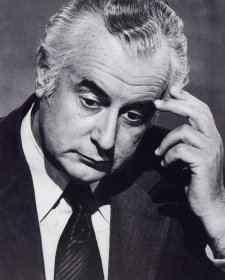
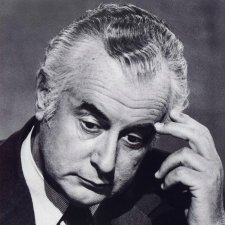
1 November 2014
On the day before the Hon. E. G. Whitlam, AC, QC, died last month, at the great age of 98, there were seven former prime ministers of Australia still living, plus the incumbent Mr. Abbott – eight in all.
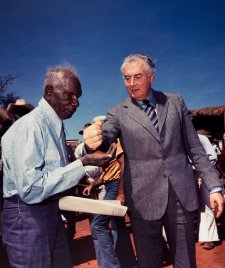
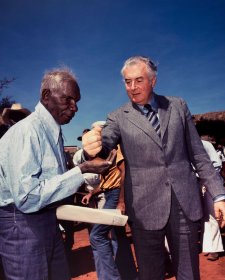
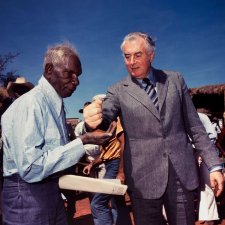
Ellen Kent examines the portrait of Vincent Lingiari and Prime Minister Gough Whitlam taken by photographer Mervyn Bishop.